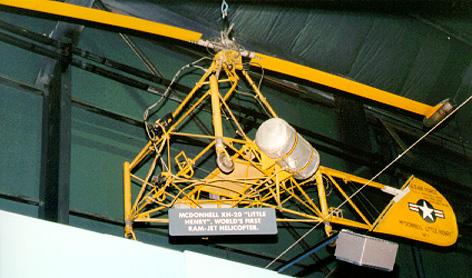The XH-20, the world's first ram-jet helicopter, was designed to serve as a test stand for studying the feasibility of using ram-jets mounted at the tips of rotor blades for power. After preliminary engineering developments, the ram-jets were mounted on a two-bladed rotor which was subsequently mounted a welded tube structure. This structure, which served as the desired test stand, was capable of controlled free flight while carrying a pilot and was therefore classified as a helicopter.
The XH-20 made a flight on May 5, 1947, but its fuel was delivered to it through a flexible line from tanks on the ground. On May 20, 1948, it made its first flight several feet off the ground while carrying self-contained fuel tanks. Being a test stand, "Little Henry" was never intended to fly at any appreciable altitudes or distances. The XH-20 on display, the only one built and flown, was obtained by the Air Force Museum in June 1953.
